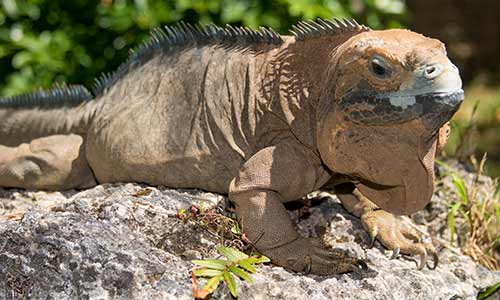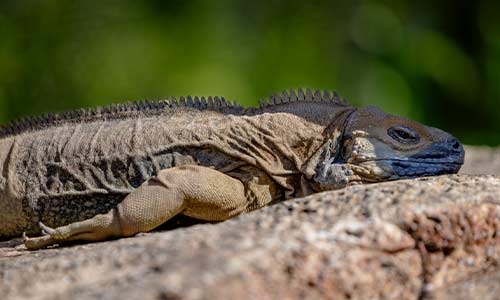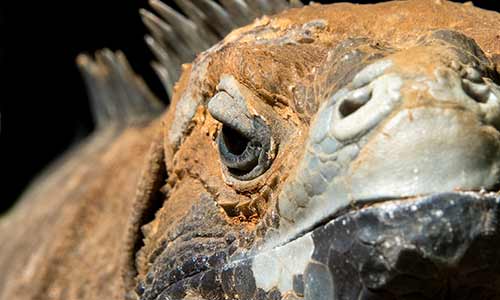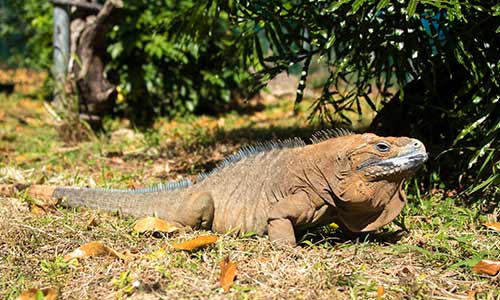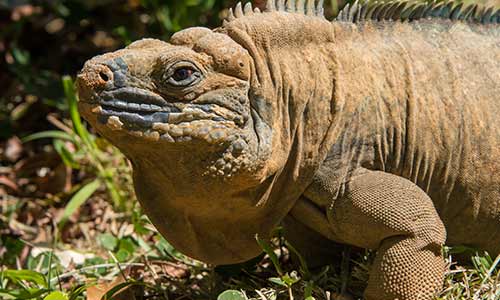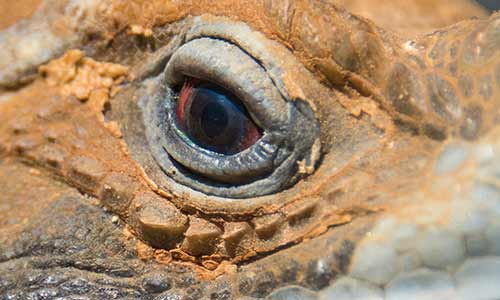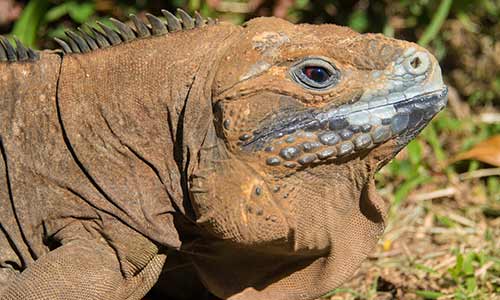Jamaican Iguana
Cyclura collei
About the Jamaican Iguana
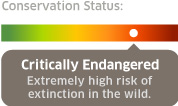
Geographic Range:
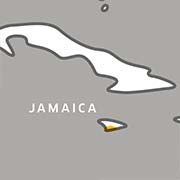
Class: Reptilia
Order: Squamata
Family: Iguanidae
Genus: Cyclura
Species: collei
The critically-endangered Jamaican iguana is the island's largest terrestrial vertebrate. They're found in the tropical dry forest and limestone outcrops, Hellshire Hills in Jamaica, at elevations below 200m. Historically, Jamaican iguanas have had a wider range, but this remote population is now the only one left outside of zoos. In fact, in 1948 they were declared extinct, before a small population was discovered in 1990. Today, there are 100 - 200 Jamaican iguanas thought to exist in the wild. Many zoos like Zoo New England are part of captive breeding programs to serve as a backup for the wild population in case of catastrophic loss, as well as for education and awareness.
Committed to Conservation
Critically endangered, there are 100 - 200 Jamaican iguanas thought to exist currently in the wild. In 1948, this species was declared extinct, before a small population was discovered in 1990. Captive breeding and a head-starting program run by Hope Zoo in Jamaica have been in place since that time, with plans to reintroduce iguanas to the Goat islands, part of their historic territory.
Many zoos in the U.S. are part of captive breeding programs for this species. The purpose of these programs is to serve as a backup for the wild population in case of catastrophic loss, as well as for education and awareness. Before reintroduction to the Goat Islands, goats and other predators must be removed to increase the chances of a population surviving. The Jamaican Iguana Recovery Group (JIRC) monitors individuals, and has shown that predator control in the area has been successful in increasing numbers of wild-born Jamaican Iguanas.
Conservation at Zoo New England
Zoo New England participates in the Jamaican iguana Species Survival Plan. By sharing research and knowledge, participating institutions work together to establish guidelines that best ensure the health of captive populations, and with success, the survival of endangered species.
You can help!
Many lizard species are threatened by the illegal wildlife trade. Responsible pet ownership is a great way to protect wildlife. Before bringing home a new pet, ask where the animal came from and if it’s legal to own where you live. Learn more about our work to save animals from illegal trafficking.
Jamaican Iguana Facts
Appearance:
The Jamaican iguana ranges from dark grey to green-blue in color, with dark, olive-brown markings. Wild female iguanas are often reddish- brown, due to digging in iron-rich soil. Their coloring allows them to camouflage with their surroundings. They have sharp claws used for digging and defense. The Jamaican iguana is the island's largest terrestrial vertebrate.
Size:
Average snout to vent length: 16.9 inches (428mm) for males; 14.9 inches (378mm) for females
Diet:
Primarily herbivorous, including leaves, flowers, and fruits. Very rarely, the iguana’s diet is supplemented with invertebrates such as snails, but this may be purely accidental while feeding.
Reproduction:
A communal nesting species, Jamaican iguanas lay six to 20 eggs in burrows in loose soil. Eggs laid mid-June, hatch 85 – 87 days later. Hatching success is closely related to the female’s body size and occurrence of rainfall extremes. Only three known communal nest sites remain in the wild.
Behavior:
Unknown due to low numbers of this species in the wild.
Habitat/range:
Tropical dry forest and limestone outcrops, Hellshire Hills in Jamaica, at elevations below 200m. Historically, iguanas have a wider range, but this remote population is now the only one left outside of zoos.
Threats:
Threatened due to deforestation and threats from non-native animals—including mongooses, cats, dogs and pigs.
Median Life Expectancy:
Unknown. Other iguana species have been documented as having life spans of 20 years or longer, both in captivity and in the wild.
Iguanas are currently off exhibit due to low temperatures. Visit our Winter Visits page to learn more about the amazing animals you can see during the winter.
You Can Find This Animal in the Caribbean Coast
Back from the Brink
In 1948, the Jamaican Iguana was considered extinct until discovered by a hunter's dogs in 1990. Today, there are under 200 Jamaican iguanas thought to exist in the wild.
You May Also Like
At Franklin Park Zoo:
At Stone Zoo:


